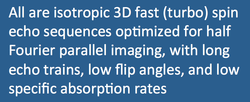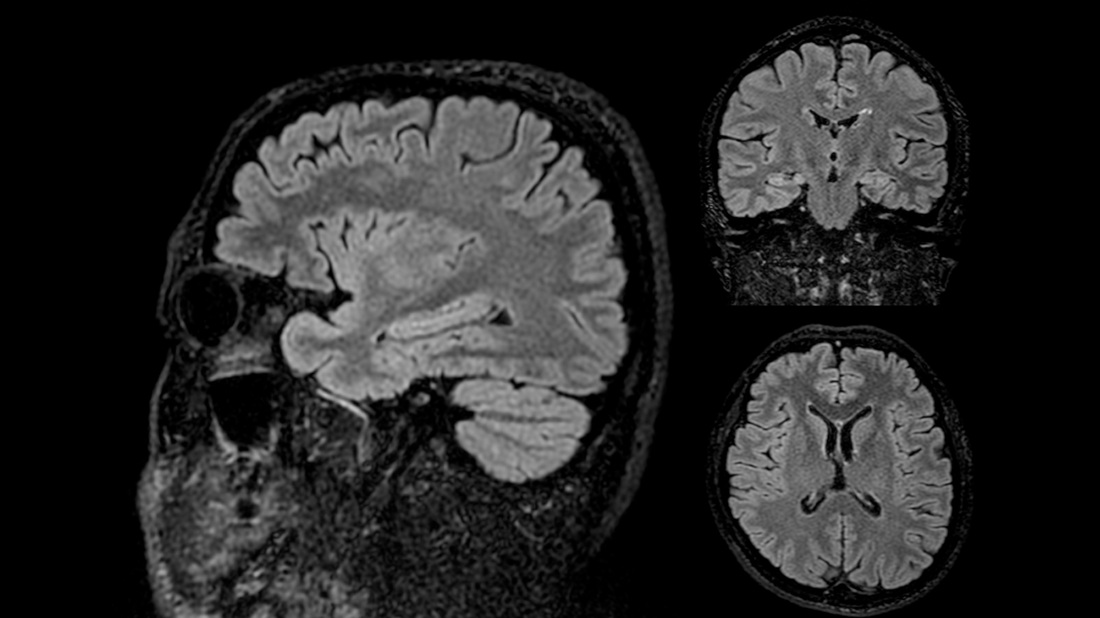|
These are closely related Fast (Turbo) spin echo techniques with special modifications optimizing them for isotropic 3D imaging. The term isotropic means that the voxels generated by the 3D acquisition measure the same in each direction, say 0.6mm x 0.6mm x 0.6mm, allowing the images to be reformatted with equal resolution in any direction.
|
CUBE is simply the GE name of their sequence and not an acronym; VISTA is the Philips version and abbreviation for "Volume ISotropic Turbo spin echo Acquisition"; Hitachi's term is isoFSE; Canon calls theirs 3D MVOX ("MultiVOXel"); Siemens' SPACE is perhaps the most creative name — "Sampling Perfection with Application optimized Contrasts using different flip angle Evolution."
The precise implementations vary among the manufacturers, but have the following elements in common:
- 3D-fast (turbo) spin echo acquisition
- Very long echo train lengths, typically 100-250 echoes
- Ultrashort echo spacing, typically 3-4 msec
- Non-selective refocusing pulses
- Reduced flip angles (may be constant but usually variable, typically 30º - 120º, to reduce tissue heating
- 1D or 2D parallel acquisition to reduce imaging time
- Partial Fourier imaging with zero-interpolation filling to reduce imaging time
- Optimized/efficient k-space trajectories with sampling in both in-plane and through-slab phase-encode directions during signal evolution
- Ability to create T1-weighted, T2-weighted, PD-weighted, or FLAIR images
- Reasonable imaging times (5-10 min)
|
SPACE/CUBE/VISTA techniques have already shown to be of value in a wide range of clinical applications, falling into two general categories:
|
SPACE MR knee study with multiplanar interactive reformations using 3D data set.
|
Advanced Discussion (show/hide)»
Additional Notes on SPACE/CUBE/VISTA
Although the refocusing pulses are typically non-selective, the excitation pulse may be either non-selective or slice selective.
Partial signal averaging is sometimes used with phase-cycling to reduce artifacts. To reduce measurement time an uneven number of signal averages may be used. In other words, averaging may take place only across the central lines of k-space.
Image contrast is not quite the same as expected with standard FSE/TSE sequences. In general the effective echo time (TEeff) must be set about 20% longer to obtain the same degree of T2-weighting.
SPACE/CUBE/VISTA is compatible with a wide range of protocols, including T1, T2, PD, T1-FLAIR, T2-FLAIR, double IR, and phase-corrected IR techniques.
References
Busse RF, Brau ACS, Vu A, et al. Effects of refocusing flip angle modulation and view ordering in 3D Fast Spin Echo. Magn Reson Med 2008; 60:640-649. [DOI Link]
Mugler JP III. Optimized three-dimensional fast-spin-echo MRI. J Magn Reson Imaging 2014; 39:745-767. [DOI Link]
Busse RF, Brau ACS, Vu A, et al. Effects of refocusing flip angle modulation and view ordering in 3D Fast Spin Echo. Magn Reson Med 2008; 60:640-649. [DOI Link]
Mugler JP III. Optimized three-dimensional fast-spin-echo MRI. J Magn Reson Imaging 2014; 39:745-767. [DOI Link]
Related Questions
What is Fast (Turbo) Spin Echo imaging?
What is Fast (Turbo) Spin Echo imaging?

